Individual differences in resting alpha band power and changes in theta band power during sustained pain are correlated with the pain-relieving efficacy of alpha HD-tACS on SM1
IF 4.7
2区 医学
Q1 NEUROIMAGING
引用次数: 0
Abstract
High-definition transcranial alternating current stimulation (HD-tACS) targeting alpha rhythms (8–13 Hz) shows promise as a pain-relieving intervention, but individual responses vary widely. Understanding the neurobiological mechanism behind this variability is crucial for optimizing HD-tACS parameters to enhance its efficacy in pain relief. In a double-blind, within-subject, sham-controlled experimental study, 34 healthy participants were recruited. We investigated how individual differences in brain oscillations during rest and capsaicin-induced sustained pain states influence the efficacy of alpha HD-tACS. Participants underwent EEG assessments at rest and during capsaicin-induced sustained pain. They then received either sham or active HD-tACS on the sensorimotor cortex (SM1) or dorsolateral prefrontal cortex (DLPFC). We found significant reductions in delta and theta band power at the C4 electrode during sustained pain correlated with individual pain intensity. Additionally, stimulating the SM1 and DLPFC significantly relieved sustained pain. Resting alpha band power and changes in theta band power during sustained pain (the difference in theta band power between sustained pain and rest) at the C4 electrode were both significantly correlated with the pain-relieving efficacy of alpha HD-tACS on SM1. Notably, changes in theta band power mediated the relationship between resting alpha band power and pain-relieving efficacy. These results were not found with alpha HD-tACS on DLPFC. Our results suggest that the variations in theta band power during sustained pain may be crucial for understanding the variability in the efficacy of alpha HD-tACS targeting SM1. The factors influencing the efficacy of alpha HD-tACS on the DLPFC might be multifaceted.
静息α波段功率和持续疼痛时α波段功率变化的个体差异与α HD-tACS对SM1的镇痛效果相关
针对α节律(8 - 13hz)的高清晰度经颅交流电刺激(HD-tACS)有望作为一种缓解疼痛的干预措施,但个体反应差异很大。了解这种可变性背后的神经生物学机制对于优化HD-tACS参数以增强其缓解疼痛的功效至关重要。在一项双盲、受试者内、假对照的实验研究中,招募了34名健康参与者。我们研究了休息和辣椒素诱导的持续疼痛状态下脑振荡的个体差异如何影响α HD-tACS的疗效。参与者在休息和辣椒素引起的持续疼痛期间接受脑电图评估。然后,他们在感觉运动皮层(SM1)或背外侧前额叶皮层(DLPFC)上接受假或活性HD-tACS。我们发现C4电极在持续疼痛期间δ和θ波段功率的显著降低与个体疼痛强度相关。此外,刺激SM1和DLPFC可显著缓解持续疼痛。C4电极的静息α带功率和持续疼痛时θ带功率的变化(持续疼痛与休息时θ带功率的差异)均与α HD-tACS对SM1的镇痛效果显著相关。值得注意的是,θ波段功率的变化介导了静息α波段功率与镇痛效果的关系。α - HD-tACS在DLPFC上没有发现这些结果。我们的研究结果表明,持续疼痛期间θ波段功率的变化可能是理解α HD-tACS靶向SM1疗效变化的关键。影响α - HD-tACS治疗DLPFC疗效的因素可能是多方面的。
本文章由计算机程序翻译,如有差异,请以英文原文为准。
求助全文
约1分钟内获得全文
求助全文
来源期刊

NeuroImage
医学-核医学
CiteScore
11.30
自引率
10.50%
发文量
809
审稿时长
63 days
期刊介绍:
NeuroImage, a Journal of Brain Function provides a vehicle for communicating important advances in acquiring, analyzing, and modelling neuroimaging data and in applying these techniques to the study of structure-function and brain-behavior relationships. Though the emphasis is on the macroscopic level of human brain organization, meso-and microscopic neuroimaging across all species will be considered if informative for understanding the aforementioned relationships.
 求助内容:
求助内容: 应助结果提醒方式:
应助结果提醒方式:


